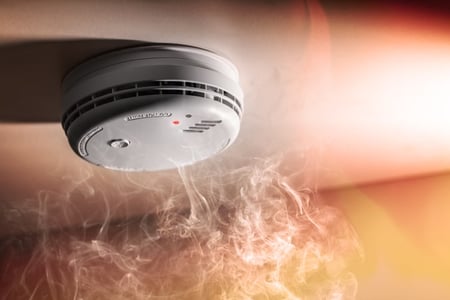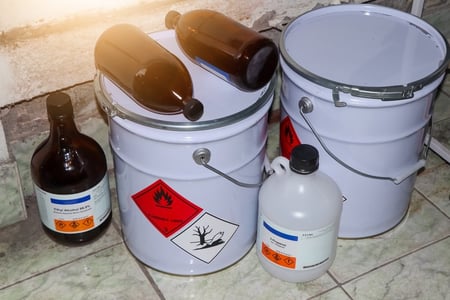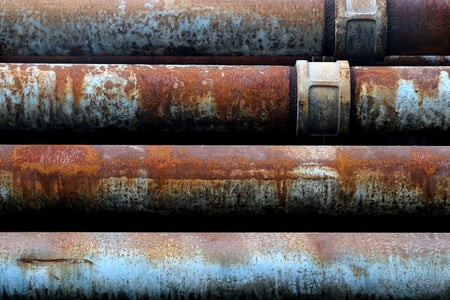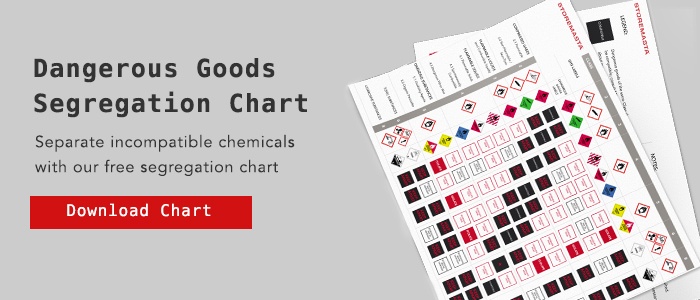Are you storing multiple classes of dangerous goods in your organisation? Safe chemical storage is a serious and often complex issue, but it becomes even more crucial an issue when your business is carrying both Class 3 Flammable Liquids and Class 8 Corrosive Substances. When there are multiple classes of dangerous goods within a workplace or on a remote worksite, there may be a potential for these chemicals to react — causing a devastating incident such as human harm or a fire, explosion or violent chemical reaction. To clear up this important issue, we thought we’d dedicate this blog to answering the question, ‘Can you store flammable and corrosive together?’
Can You Store Flammable Liquids and Corrosive Substances Together?
In Australia, Class 3 Flammable Liquids and Class 8 Corrosive Substances are regarded as incompatible dangerous goods. This means that it is unsafe for these chemicals to be stored together. Flammable liquids and corrosive substances must be separated by at least 3 metres if they’re stored in a shared area – or the chemicals must be separately stored in compliant chemical cabinets that offer in-built segregation controls.
But before we get into the subject of dangerous goods segregation — let’s look at the chemical properties and definition of both flammable liquids and corrosives.
What are Flammable Liquids
Flammable liquids are liquids, or mixtures of liquids, or liquids containing solids in solution or suspension which give off a flammable vapour at temperatures of not more than 60 °C, closed-cup test, or not more than 65.6 °C, open-cup test, normally referred to as the flash point.
The ‘flash point’ is the temperature at which a flammable liquid gives off enough vapour for it to ignite — in the presence of an ignition source. Flammable liquids are substances, as explained above in the ADG Code, which have the potential to ignite at low temperatures.
Flammable liquids fires burn and spread quickly — they are notoriously difficult to put out. These fierce blazes often engulf warehouses or businesses, destroying property and the environment, emitting plumes of toxic fumes, and putting human life at risk.
While flammable liquids are found in almost every Australian workplace, it doesn’t mean that these chemicals should be handled by just any staff member or contractor. Class 3 Flammable Liquids require comprehensive flammable liquids training and must be stored, transferred and decanted in the correct and compliant way in order to reduce risk of fire, explosion and human harm.

Flammable liquids emit flammable gases which can easily ignite if they meet an ignition source in your workplace.
Key Points To Consider When Using Or Storing Flammable Liquids
- Low flash point – this means that your flammable liquids have the capability to ignite at room temperature. Ignition sources must be kept at least 3 m away from your flammable liquids.
- Hazardous vapours – your flammable liquids emit hazardous vapours at a certain temperature, which can lead to asphyxiation and human harm. The vapours can also travel quickly and cause a fire or explosion if they meet an ignition source.
- Spill and vapour containment – to reduce the risks associated with the handling and storage of flammable liquids, you must have risk control measures in place to contain and manage chemical spills and hazardous vapours.
- Human harm – flammable liquids must be carefully handled by your team, as vapours and liquids that make contact with the eyes or skin can cause immediate health effects, such as burns, nausea and dizziness.

Exposure to Class 3 Dangerous Goods can cause adverse health effects including nausea and dizziness.
Some Examples Of Common Flammable Liquids
As we’ve already mentioned, Class 3 Flammable Liquids are found in just about every workplace (and backyard shed).
Commonly used flammable substances include:
- Petrol
- Diesel
- Paint
- Paint thinners
- Acetone
- Toluene
- Diethyl ether
- Benzene
- Ethanol
- Methanol
If you are carrying any chemicals that are classed as flammable liquids, you must ensure they are handled and stored in a compliant manner.
What are Corrosive Chemicals?
Substances which, by chemical action, will cause severe damage when in contact with living tissue, or, in the case of leakage, will materially damage, or even destroy, other goods or the means of transport.
As explained in the ADG Code, corrosives are defined by their ability to corrode living tissue and materials such as metal and stone.
Due to the destructive nature of the chemical, Class 8 dangerous goods require strict workplace protocols if they are being handled, transferred, decanted or stored.
Corrosive substances have the potential to quickly degrade property and vehicles — and can cause immediate (and severe) human harm. If spilt on the skin or splashed in the eyes of staff, corrosive substances can rapidly corrode human tissue, resulting in skin irritation, burns, bodily injury and blindness.
There are 2 main types of corrosive substances: acids and bases. It’s vital that acids and bases are segregated in the workplace, as they can react with each other.

Corrosive acids and bases are incompatible substances and must never be stored in the same work area.
Corrosive acids and bases have the potential to neutralise each other, resulting in hazardous situations such as the creation of poisonous salts. Before storing two different corrosive substances together, you must find out if they are compatible chemicals. You can do so by referring to the safety data sheet (SDS) for each corrosive substance.
Key Points to Consider When Using or Storing Corrosive Substances
- Incompatibility between corrosive substances – ensure the safety data sheets for all corrosives are on hand, so you can segregate incompatible Class 8 Dangerous Goods.
- Corrosive properties – as corrosive substances can attack living tissue as well as a range of materials, including metal, extreme caution must be taken to ensure chemical spills and leaks don’t occur.
- Emergency equipment – corrosive-resistant gloves, eye protection and PPE must be provided for staff handling corrosives. Eyewash stations and safety showers must also be installed, and chemical spill kits must be available in the event of a spill.
- Human harm – all corrosive substances must be carefully handled by staff to ensure that the risk of chemical spills, leaks or accidental splashes are reduced and managed.

Corrosive substances will chemically attack living tissue as well as a range of materials including metal and stone.
Examples of Corrosive Substances
From manufacturing plants to laboratories, corrosive substances can be found in a vast range of workplaces. Some common examples include:
- Sulfuric Acid
- Hydrochloric Acid
- Glycolic Acid
- Nitric Acid
- Citric Acid
- Bromine
- Hydrogen Peroxide
- Calcium Hydroxide
- Sodium Carbonate
- Aluminium Hydroxide
Are you carrying incompatible dangerous goods?
ACCESS OUR CHEMICAL SEGREGATION CHART
Segregation of Incompatible Substances
As we mentioned earlier in the article, these two classes of dangerous goods are incompatible. Therefore, the rules of dangerous goods segregation apply.
As flammable liquids and corrosive substances must be separated by at least 3 metres, it is often more practical to store each class in its own compliant chemical storage cabinet. Storage in dedicated chemical cabinets provides effective segregation, and allows businesses to maximise their floor space instead of spreading out incompatible classes to meet the segregation distances.
The Australian Standard AS 3833:2007 - The storage and handling of mixed classes of dangerous goods, in packages and intermediate bulk containers, explains that Class 3 Flammable Liquids and Class 8 Corrosive Substances must not be stored together.
If these dangerous goods mix, a chemical reaction may occur which will result in the production of large quantities of toxic or flammable gas. If flammable gas develops, there is potential that it could come into contact with an ignition source — causing an explosion or fire. If toxic gas is created, it can have severe effects upon human health — including suffocation and burning of internal organs.
By understanding the chemical and physical properties of the substances that you are using (and their dangerous goods classification), you will be able to implement risk control measures to ensure that incompatible substances — such as Class 3 Flammable liquids and Class 8 Corrosive Substances — are not stored together.
REMEMBER: For workplaces that rely on a range of dangerous goods classes, it’s important to fully understand and meet the segregation requirements set out in AS 3833:2007.
Storing Dangerous Goods: Features of a Compliant Safety Cabinet
To help you better understand your obligations with the safe storage of dangerous goods, we’ll take a look at the features that make flammable cabinets and corrosives cabinets the best choice for storing these separate classes of Dangerous Goods.
Let’s start with the flammable liquids storage cabinet.
What are the Features of a Flammable Cabinet?
- Flammable cabinets are constructed in compliance with AS 1940:2017 - The storage and handling of flammable and combustible liquids
- Double-walled sheet steel construction, 40mm thermic air barrier
- Liquid-tight spill containment sump, 150mm deep
- Storage cabinets feature self-closing, close fitting doors that latch at two points
- Sequential door closing system
- Adjustable perforated shelving for free air movement, 100mm adjustment increments

You must only store Class 3 Flammable Liquids in your flammable cabinet.
What are the Features of a Corrosive Storage Cabinet?
- Constructed in compliance with AS 3780:2023 - The storage and handling of corrosive substances
- A corrosive storage cabinet offers liquid-tight spill containment, with a sump that’s 150mm deep
- Storage cabinets feature self-closing, close fitting doors held shut by catches at 2 points. The doors do not open inwards and are capable of being opened from within the cabinet
- Sequential door closing system
- Adjustable perforated shelving for free air movement, 100mm adjustment increments
- Powder coat finish for high durability and performance
- PVC spill trays for shelves providing corrosion protection
Your corrosive storage cabinet is specifically designed and manufactured to meet the requirements of AS 3780:2023.
As we’ve detailed above, if you want to safely store a particular class of dangerous goods, it’s best practice to choose a compliant safety cabinet that’s designed and constructed to suit the type of chemical that you carry. Flammable liquids and corrosives have different chemical and physical properties, which make them incompatible substances.
Therefore, you must segregate incompatible substances by storing them at least 3 m apart — or storing each class of dangerous goods in its own safety cabinet or store.
Like to Know More About Chemical Segregation?
In this blog, we’ve mentioned incompatibilities between Class 3 Flammable Liquids and Class 8 Corrosive Substances, but there are many more chemicals that can react dangerously if they are stored or handled in the same work area. If your business has any type of Dangerous Goods, we urge you to learn more about the chemical segregation of incompatible substances. Why not download our free Segregation Chart and ensure your chemicals are stored safely and in full compliance with the Australian Standards and WHS Regulations.
Joining the team as a Dangerous Goods Storage Consultant, Melissa Hampton became Storemasta's Marketing Manager in late 2021. With extensive knowledge and experience in chemical compliance, Melissa is responsible for leading the Marketing team and helping shape their marketing strategy. In her spare time, you can find Melissa hiking, swimming and enjoying the great outdoors in beautiful north-west Tasmania.

%20(1).png?width=500&height=272&name=SC1008-min%202%20(1)%20(1).png)
